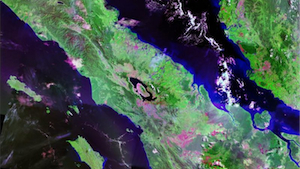People survived the Toba supervolcano’s global winter after all

Landsat image of Lake Toba (credit: NASA)
A supervolcano eruption 74,000 years ago wasn't enough to stop humanity in its tracks, artifacts at a Paleolithic site in central India suggest. The study is the latest strike against a hotly debated proposal that suggests the eruption of Indonesia's Toba supervolcano had a huge influence on human evolution. The idea is that the eruption caused global cooling that killed most of the humans who had spread from Africa into Europe and Asia. But at the Dhaba site in Madhya Pradesh, India, archaeologists found stone tools in sediment layers spanning thousands of years before and after the eruption-evidence that human life went on.
An ancient apocalypse?Today, the Toba supervolcano lies beneath the strikingly scenic Lake Toba on the Indonesian island of Sumatra. Seventy-four thousand years ago, it erupted in the middle of an important chapter in humanity's takeover of the world. One of archaeology's biggest questions in recent years has been when and how people first spread beyond Africa into different areas of the world; the answers lie in fossilized skeletons, objects left behind, and the DNA of modern people.
Fossil evidence suggests that people had reached the Levant by around 200,000 years ago, the Arabian Peninsula by around 85,000 years ago, and northern Australia by around 65,000 years ago. But the genomes of modern people suggest that the ancestors of modern African and non-African peoples branched off from a common ancestor around 70,000 years ago. At first glance, those lines of evidence don't seem to agree, and some paleoanthropologists say that's because a sudden, lengthy period of global cooling changed environments around the world in very drastic ways. The resulting crisis allegedly killed off most of the people alive at the time, leaving only a few thousand survivors.
Read 8 remaining paragraphs | Comments